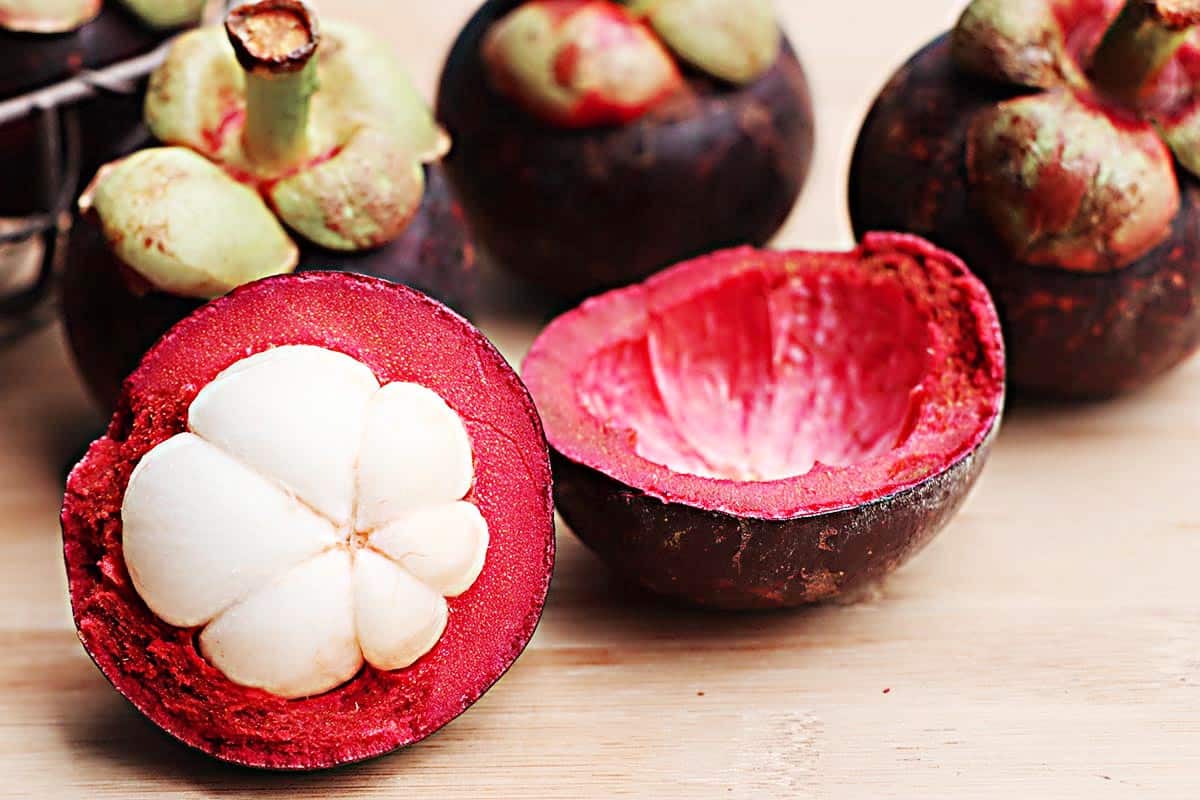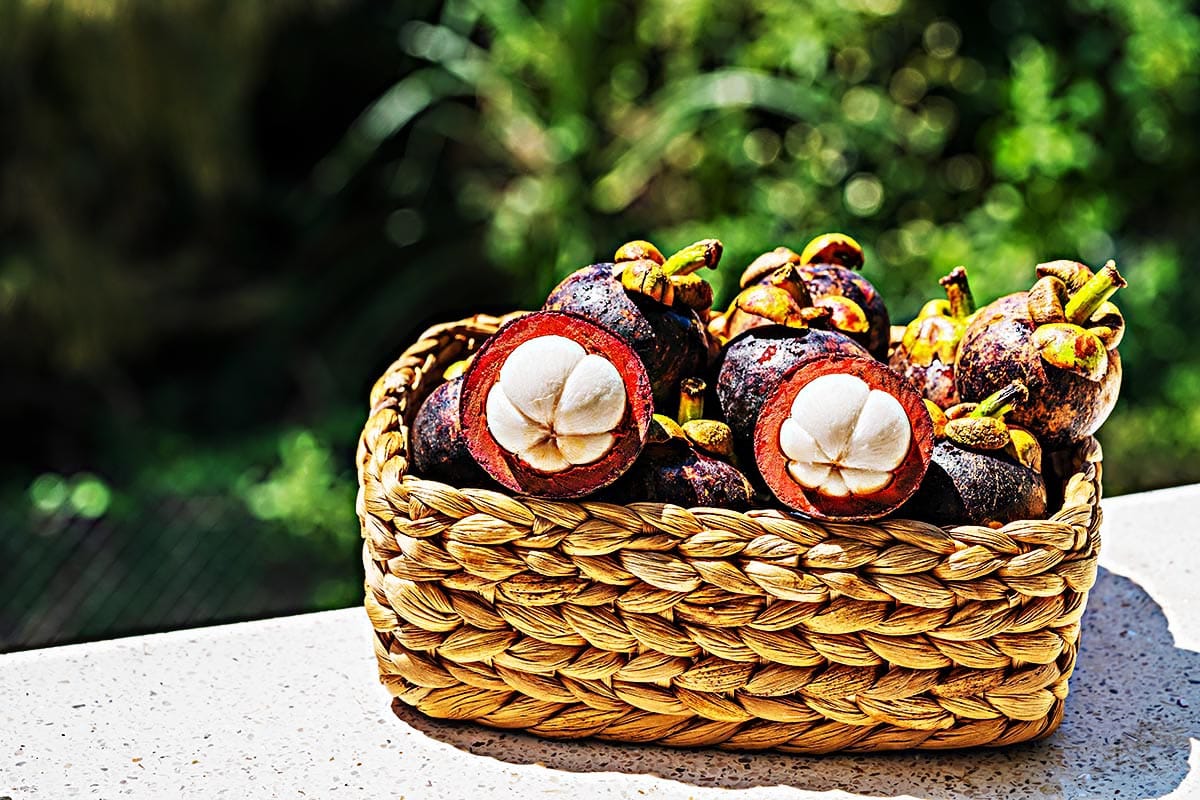Mangosteen is an incredibly versatile fruit that can be enjoyed fresh or dried, juiced, eaten as a snack, or added to desserts and other dishes. It’s a delicious and beneficial addition to any diet! Whats does mangosten taste like?
The taste of mangosteen is unique compared to other tropical fruits. There’s a reason people call this wonderful fruit the “Queen of Fruits.” In fact, it was one of Queen Victoria’s favorite delicacies. Learn all about this exotic fruit’s flavor in this ultimate fruit guide. Plus, explore all the ways to use mangosteen in many recipes.

Mangosteen is a tropical fruit native to Southeast Asia. Mangosteen has a hard outer shell that turns from pale green to dark purple as they ripen. The softer inner rind holds the flesh together.
The pulp makes up snow-white segments that resemble those of an orange. Mangosteen’s flesh is also similar to that of cacao and rambutan.
The mangosteen fruit has over 200 species around the world. But commercially grown mangosteen comes from the specie “garcinia mangostanica.”
You can get this exotic fruit fresh or canned in many grocery stores. But they’re easier to find at wet markets throughout Asia.
Mangosteen was first cultivated in Thailand and distributed across its neighboring countries. Mangosteen is not as widely available in the US as other tropical fruits. This is because the mangosteen plant is difficult to grow.
The mangosteen tree needs specific requirements to grow. Compared to other fruits, mangosteen requires consistently high temperatures. Farmers keep the seeds in the shade and avoid transplanting them.
Mangosteen trees also take a long time to produce fruit. The first harvest may come six to eight years after the seeds are sown. Even when they do bear fruit, the trees may give inconsistent yields.
Mangosteen fruits are delicate, and once they’re picked, they will stop maturing. This is why they’re best eaten fresh from harvest. They’re also seasonal and are only available from November to February.
Since it’s a seasonal and high-maintenance fruit, mangosteen can be pricey in the US. You’re more likely to find them in Asian markets, though. But if you want to enjoy this fruit year-round, consider buying the canned variety or look for mangosteen juice.

So now you’re probably itching to know, what does mangosteen taste like?
Mangosteen has a sweet and tangy flavor with notes of peach, cherry, and strawberry. The flesh inside the fruit is juicy and creamy in texture. It has a unique tartness that sets it apart from other tropical fruits like pineapple or banana.
The taste of mangosteen can be described as a cross between grapes and citrus fruits. Its sweetness and tartness make it more complex than other fruits, making it a truly unique taste experience.
This exotic fruit has a complex flavor profile that’s also delicate on the taste buds. It has a distinct sweet taste with hints of a sourness after each bite.
Mangosteen tastes different when unripe. The flesh is not as juicy nor fresh. At this stage, it will only taste like a watery vegetable. This is because its natural sugars have yet to develop fully.
Unripe mangosteen will have white or green peels. The best way to tell if the fruit is ripe is if it has a purple or magenta-colored peel. Remember that picking mangosteens before it’s ready stops the ripening process.
Yes, the taste of mangosteen changes when frozen. In fact, mangosteen is one of the few fruits you should never freeze. Unlike most fruits, the freezing process affects the mangosteen’s flavor.
Freezing mangosteen will cause it to bruise and dry out its juices. Instead of its usual sweet flavor, mangosteen will have a dry and bitter flavor. Its citrusy aroma will be gone, and you’ll only have a bland fruit.
Commercial mangosteen only comes from a single variety. But there are many types of mangosteen to choose from.
White mangosteen is also known as “jelly fruit.” True to its name, this fruit has a lighter and more jelly-like flesh when cut open. The seeds are bitter, but the flesh is a perfect balance of sweet and sour.
Red mangosteen has a distinct reddish peel. The flesh is also creamier and sweeter. We don’t recommend eating the seeds as they taste bitter.
Purple mangosteen is the most common variety. It has a purple or magenta peel with cream-colored flesh. This fruit has a unique sweet flavor, tangy notes, and a slightly bitter aftertaste.
Mangosteen is a versatile tropical fruit. It’s popular in many dishes across Southeast Asia. You can even eat mangosteen raw or served with other ingredients.
Here are a few examples of how to best enjoy mangosteen.
Mangosteen juice is a refreshing drink for summer. To make one, scoop out a mangosteen’s creamy flesh and juice it. You’ll have a sweet and tangy drink.
Having a piece of mangosteen with your breakfast will give you tons of energy for the day. You can use bits of mangosteen as toppings for cereal, oatmeal, or overnight oats. Mangosteen also makes great toppings for waffles and pancakes.
Mangosteen also tastes delicious in fresh salads. It pairs well with citrus fruits like oranges and grapefruit. Drizzle your mangosteen salad with honey, yogurt, or any dressing of your preference.
Another creative way to serve mangosteens is to include them in pastries. You can use this fruit as a filling for tarts and pies or mix it into your scones and fruit cake batters.
The mangosteen taste is a perfect ingredient for desserts. You can make it into jam, spread, or use the juice for popsicles. This fruit is also great candied, dried, or preserved.
Mangosteen has many health benefits since it offers many vitamins and minerals.
It’s incredibly rich in fiber, which might help to improve gut health.
Mangosteen is also rich in antioxidants that help fights radical cells in the body, which makes it an excellent choice for those looking to improve their overall health and wellbeing.
If you’re keeping an eye on your blood pressure, adding mangosteen to a well-balanced diet can help. It has tons of potassium and magnesium that promote heart health.
Plus, mangosteen is rich in vitamin C, which is essential to a healthy immune system.
Many like adding this fruit to their diet by eating it raw or taking mangosteen capsules.
The best way to eat mangosteen is to eat it fresh and ripe.
To know if it’s fully ripe, it should have a vibrant purple peel. It should also feel heavy on your palm.
If you press the skin, it should yield under gentle pressure.
Wash the mangosteen and remove the brown crown. Then run a knife along the circumference of the fruit. After cutting, gently squeeze the rind and pull the peels apart.
This process should give you a clean cut around the mangosteen’s creamy flesh. We don’t recommend eating the seeds or peels because they’re inedible.
If you can’t freeze mangosteen, then how do you store it? Mangosteen is a delicate fruit that’s tricky to keep.
After buying this fruit, it’s recommended to be eaten within 48 hours. Remember that mangosteen spoils very fast.
You can also store mangosteens in the fridge, but we don’t recommend keeping them in there for long. Mangosteens can only last five days in the fridge before it starts drying out.
A dry and cool pantry away from sunlight is a suitable place to store this fruit.
Mangosteens are expensive because mangosteen trees are a slow-growing crop. Yields can be unpredictable, and the fruits have a short shelf life. The added importation costs also add to the mangosteen’s hefty price tag.
Mangosteen got the nickname “Queen of Fruits” mainly for its unique sweet and sour flavor. It’s also highly nutritious and has many culinary uses. Mangosteen is also believed to be Queen Victoria’s favorite fruit.
Yes, mangosteen was once banned in the United States. The fruit attracts the Asian fruit fly, which can be a major pest. After fumigation and irradiation efforts, the importation ban was finally lifted in 2007. So it’s easier now to buy mangosteen in the US.
Mangosteen is a tropical fruit that’s very popular in Southeast Asia. It has a purple peel, creamy flesh, and citrusy aroma. Mangosteen spoils quickly, so we recommend eating it immediately after buying it.
So, what does mangosteen taste like? The fruit has a sweet flavor with a slightly tangy aftertaste. It tastes best when eaten fresh or added to refreshing smoothies and salads.





